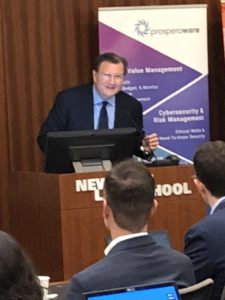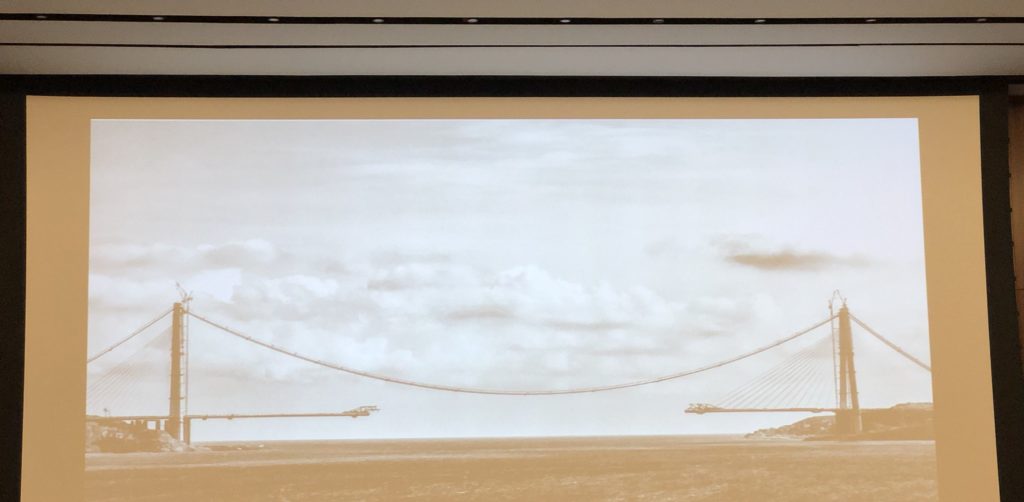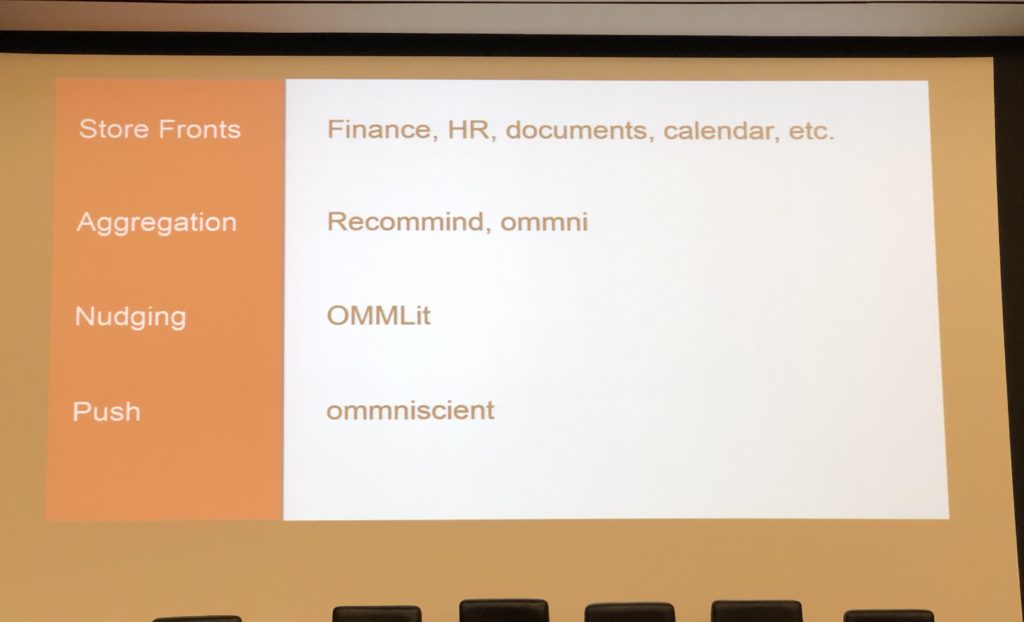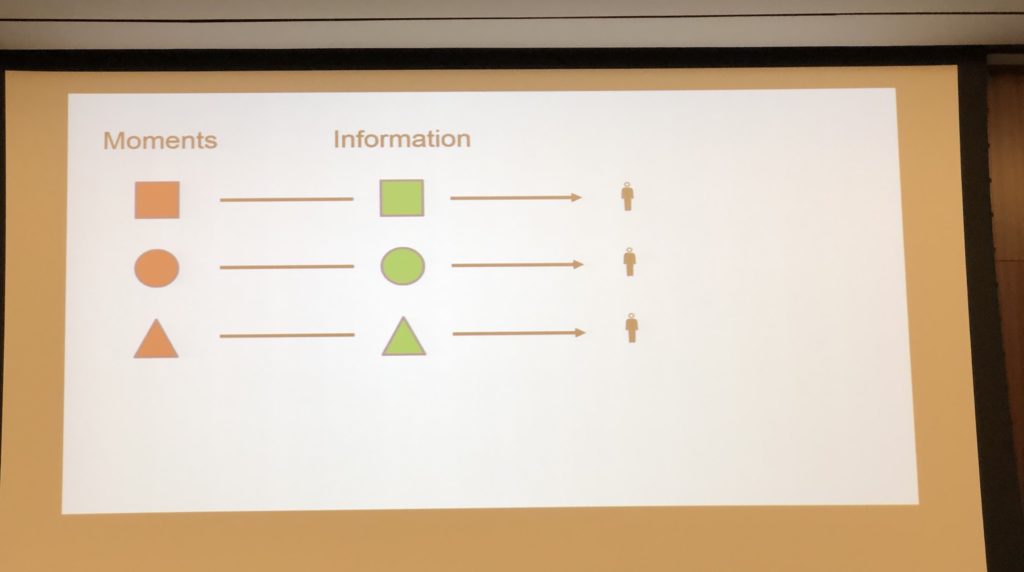Redesigning Law Firm Knowledge Management is a live post from the conference Knowledge Management in the Legal Profession, presented by Ark. I post as a session ends, so please forgive typos or errors in understanding.
The presenter is Jeff Rovner, Managing Director of Information, O’Melveny & Myers LLP. The session description appears at the end.

The Problem of Adoption. Jeff opens with a story about talking to litigators and their interest in learning more about judges they would appear before. They wanted information from colleagues, and about analytics of rulings. Yet almost none knew how to use existing tools to get that information. The moral: adoption is hard. Others in audience (show of hands) say they’ve had this experience. Multiple hands go up when Jeff asks audience if they would trade 25% better uptake of existing tools versus something shiny and new.
Jeff notes, however, the OMM tools have won awards, that clients regularly report to firm that OMM tools are differentiators, and metrics show high use of some tools. Nonetheless, Jeff notes the last mile problem – the gap between what’s available and what they use.

Rolling Out New KM Tools. As firms create new tools, the way they communicate the existence by email. And subject says “Please Read”. War stories from champions are included. But many do not read the email or are busy on training day. On training day, however, many who signed up now don’t attend. The training goes forward. By the time those attendees have an opportunity to use the took, they forgot what they learned. And the few who use it are underwhelmed and go back to old way. Someone at Harvard coined the 9x problem: for users to adopt new way / new tech, it has to be 10x better. (Contrast this to the advocate’s enthusiasm. Versus the the user inertia or skepticism.)” If you have tried to replace email with any other tool, you know what I mean”
A New KM Model – 1. After thinking about above, Jeff concluded we need a new KM model. To think about this problem, Jeff thought about leading online retailers. They have to get customers coming back repeatedly. To illustrate, Jeff reviews evolution of online shopping:
- Online started with every retailer having its own store front and there was no Google or Yahoo to aggregate. The sites were ugly and disappointing to visitors. Early storefronts often required calling.
- Five years later, the aggregators arrived: Google, Apple, Netflix, and Amazon. All of these carried not only popular items, but also obscure ones (“the long tail”). To let users find the right product, they introduced faceted search to accelerate finding it.
- Third stage of online shopping used “Nudging”, AKA recommendation engines. Leading sites show what other shoppers’ have purchased or use intelligence to recommendations.
- Now, retailers are moving to a PUSH model. To get last dollar from shopper, retailers don’t require that shoppers look for a product. Ads come to you via networks of advertising information. Cross platform ads follow users. [RF note: I’m glad I don’t see this – I use AdBlocker.] Jeff acknowledges the creepiness factor but acknowledges buying products based on ads that follow him.
Each of these incremental steps has yielded more spending. How do we apply this model to law firms?
A New KM Model – 2. Evolution in law firms was similar. Early efforts were focused on individual practices. Content managers delivered information as requested. Lawyers had to have imagination to understand firm’s data, know who to call, and know what to ask for. Much law firrm data was never conveyed to lawyers because no one had imagination to know how to deliver.
That led to aggregation with enterprise search (eg, Recommind or Insight). These tools produce good results – buyers will find something useful. O’Melveny went beyond search – it created ommni to serve up information from previously disparate systems. With ommni, lawyers don’t need to know where information lives, or even to ask for it.
The firm then moved to the nudging model with a tool called OMMlet. It is task oriented. It covers 400 tasks and, for each, offers tools and best practices. Point is to get lawyers to answer quickly, without having to know where it is coming from. Though many litigators did come to OMMLet, many did not – still the last mile problem.
To get to 100% adoption, law firms will need to adopt the push model. And 100% should be the goal – it deliver efficiency and client value, which should show in pricing. Push is needed because there will be tools and information that don’t easily fit into the aggregation or nudge model. Note that most info today is received by email or from colleagues. But if that same info is only available in a new software app, we face the 9X problem. The chance that lawyer will read email, decide to attend, actually attend, and then remember, and then find it 10X better… is low. We can’t hold KM hostage to so many chance events.
ommnicisent is firm’s new push model. It defines moments when lawyers need information. An example is when a new matter is opened. Another is when a judge is assigned to case. It’s necessary to dissect internal and external sources to understand what they contain. Final step of plumbing is connecting the two and pushing to lawyers.
First example of ommniscient staffing email. When matter opens, email is sent. It draws from five different systems, offers five most suited lawyers. It draws on experience, availability, cost, proximity, and seniority. Thanks to this, work coordinators now have information they can act on. The 9X problem avoided because information comes to users.


OMM moves to push
Redesigning Law Firm Knowledge Management
Whether they have intended to do so or not, law firms have been conducting a 20‐year longitudinal study to determine whether their lawyers can share knowledge effectively through software. The results are in, and they are decidedly mixed. That is especially unfortunate because today’s law firm business model increasingly depends on delivering the right informationon to the right people at the right moment. The time has come to revisit our basic assumptions and design a better approach. Jeff Rovner, Managing Director for Information, O’Melveny & Myers LLP
Archives
Blog Categories
- Alternative Legal Provider (44)
- Artificial Intelligence (AI) (57)
- Bar Regulation (13)
- Best Practices (39)
- Big Data and Data Science (14)
- Blockchain (10)
- Bloomberg Biz of Law Summit – Live (6)
- Business Intelligence (21)
- Contract Management (21)
- Cool Legal Conferences (13)
- COVID-19 (11)
- Design (5)
- Do Less Law (40)
- eDiscovery and Litigation Support (165)
- Experience Management (12)
- Extranets (11)
- General (194)
- Innovation and Change Management (188)
- Interesting Technology (105)
- Knowledge Management (229)
- Law Department Management (20)
- Law Departments / Client Service (120)
- Law Factory v. Bet the Farm (30)
- Law Firm Service Delivery (128)
- Law Firm Staffing (27)
- Law Libraries (6)
- Legal market survey featured (6)
- Legal Process Improvement (27)
- Legal Project Management (26)
- Legal Secretaries – Their Future (17)
- Legal Tech Start-Ups (18)
- Litigation Finance (5)
- Low Cost Law Firm Centers (22)
- Management and Technology (179)
- Notices re this Blog (10)
- Online Legal Services (64)
- Outsourcing (141)
- Personal Productivity (40)
- Roundup (58)
- Structure of Legal Business (2)
- Supplier News (13)
- Visual Intelligence (14)
